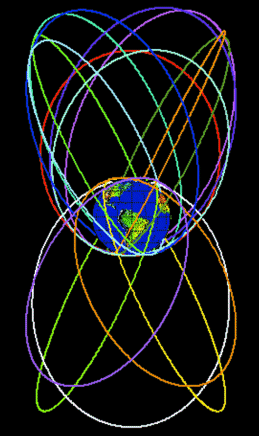A new type of orbit could help avoid signal interference between spacecraft in low, medium and geostationary earth orbits
Tim Furniss/LONDON

A NEW WASHINGTON-based company is urging the US Federal Communications Commission (FCC) to make compulsory the use of "virtual geostationary orbits" (VGSOs).
This would avoid anticipated future signal interference between spacecraft operating in low, medium and geostationary earth orbits (LEO, MEO and GEO). The major concern about signal interference involves the high frequency Ku-band, used by most communications satellites, either exclusively or shared with C-band - and sometimes S-band and Ka-band - on the spacecraft.
The FCC has said that it is concerned that GEO Ku-band payloads will be affected increasingly by interference not only from new GEO satellites operating in the Ku-band, but also by the new breed of largely Ku-band multimedia satellites planned for or operating in LEO and MEO. A factor in Ku-band's widespread use is that it requires only small receiving dishes.
Virtual Geosatellite has applied to the FCC for a licence to begin operating within five years a $2.6 billion system called Virgo. It also has patents pending covering the unique VGSO elliptical orbit, to be used by the satellite network to provide affordable Internet and video services worldwide.
The system would re-use the frequency spectrum now assigned to GEO satellites, without interfering with their signals. The company says: "We are specifically addressing the Ku-band, where the incumbent GEO satellites are very heavy users of those frequencies."
If the FCC insists that virtual geostationary orbits be used for Ku-band services, Virtual Geosatellite recommends that all new non-GEO entrants to the market use that type of orbit. VGSOs use a specific pattern of inclined elliptical medium earth orbits, which, at the highest points of their orbit - about 27,000km - appear to "hang" over their service areas, so that a satellite appears almost stationary in the sky to a user, compared with a completely stationary vehicle, as would a GEO satellite in a circular orbit of 6,000km.
Eutelsat, the European telecommunications satellite system operator, which has 14 satellites in GEO, confirm that there is a "potential problem", with interference from non-GEO systems. Eutelsat reports that the International Telecommunications Union (ITU) "has accepted the principle of a shared use of Ku-band by GEO and non-GEO satellites, only at this stage to the extent that sharing is feasible".
Pondering the situation
The ITU is studying the situation. Virtual Geosatellite says that, for all the new non-GEO Ku-band frequency satellite services being introduced, the best way to protect systems from harmful interference would be the VGSO. Its first advantage is that GEO is relatively full.
"If you want to start a new system, it is better to do so somewhere else, in LEO or MEO," says Virtual Geosatellite. Secondly, VGSO would also be technically superior to standard LEO and MEO circular orbits, it says, in avoiding interferences with GEO frequencies.
The 15-satellite Virgo system would use a specific pattern of inclined elliptical MEOs, in which spacecraft would appear to "hover" over service areas. Virgo's virtual geostationary, 63.4¼-inclination, 27,388 x 517km satellite constellation orbits will have a minimum angular separation from the geostationary satellite arc of at least 40¼ or more, compared with the 10¼ separation achieved by LEO and MEO circular orbits. These systems rely on a complex system of satellite co-ordination, exclusion zones and other artificial constraints to avoid interference with GEO systems. The Virgo's positioning therefore enables allocated frequency bands to be "re-used", creating more spectrum for satellite systems.
The Virgo system's orbital architecture achieves "a coherent constellation movement synchronised with all the main continents, in which spacecraft will appear to be virtually geostationary to users". The satellites will use a "bent pipe mode", allowing complex processing to be completed by ground stations, with customers using 50cm-diameter dishes.
Virtual Geosatellite is 12% owned by Ellipso, a company that is already developing an L-band worldwide mobile communications satellite constellation. Ellipso's orbit is also virtually geostationary, but is an L-band low data rate system, rather than a high data rate like Virgo's. "Since Virgo has to use Ku-band, it was an absolute requirement not to interfere with GEO satellites", says Virtual Geosatellite.
A VGSO system would also assist in avoiding the feared build-up of traffic in GEO and potential interference between them in this orbit. Since the launch of the world's first artificial satellite, the Soviet Union's Sputnik 1, in October, 1957, more than 5,170 craft have been launched into space. Over 2,680 are still aloft, mainly in earth orbit. Of this number, about 700 objects are in GEO, over 260 being still operational. More than 160 are large pieces of debris, particularly the upper stages of Russian Proton K boosters.
The GEO listing does not include classified US early warning satellites and some military communications spacecraft. No major problems with GEO inter-satellite interference have so far occurred, although Eutelsat has an ongoing argument with Luxembourg's Société Européenne des Satellites over craft being operated just over 3¼ apart at 16¼E and 19.2¼E, respectively, in GEO.
Sporadic interference has erupted, however. The equivalent power at which the signal is emitted by the satellites to their service area (called EIRP) have similar characteristics as that for direct-to-home television services, and Astra has chosen to use a 60cm dish rather than an ITU-recommended 80cm dish. Some Astra users are pointing their dishes too close to the Eutelsat spacecraft.
The ITU says that 60cm dish user satellites with similar EIRP should be spaced 6¼ apart in GEO. Interestingly, Eutelsat has five Hot Bird satellites co-located at 16¼E "several kilometres apart" and no interference is being experienced. As to an actual traffic jam in GEO, Eutelsat says this is a problem on paper only, since, although a rapidly increasing number of satellite networks are being proposed and filed with the FCC, many "may never be implemented".
Source: Flight International























